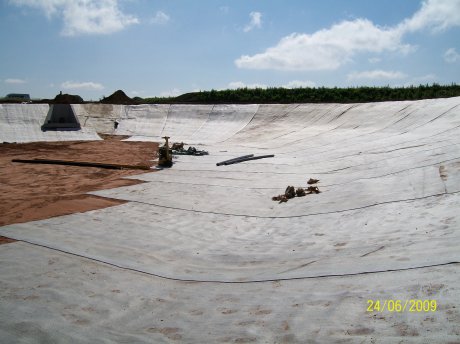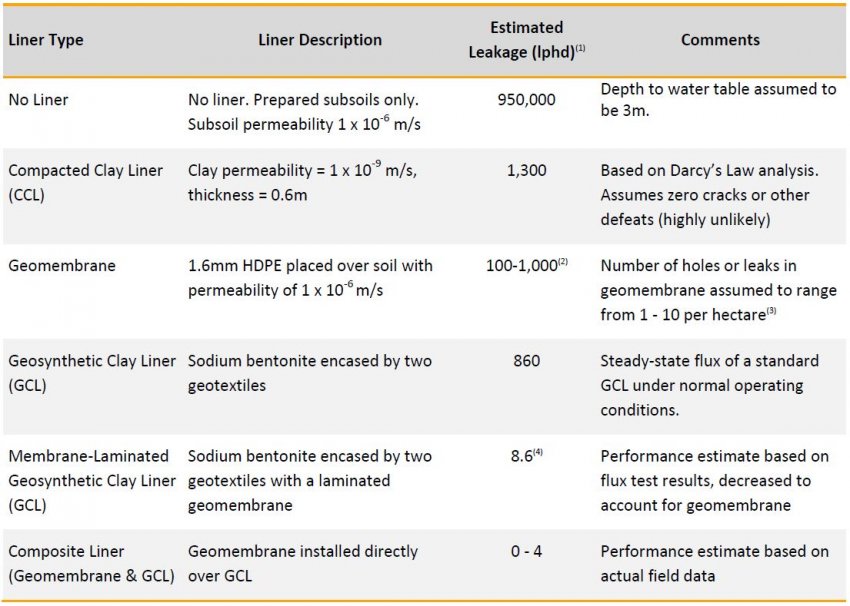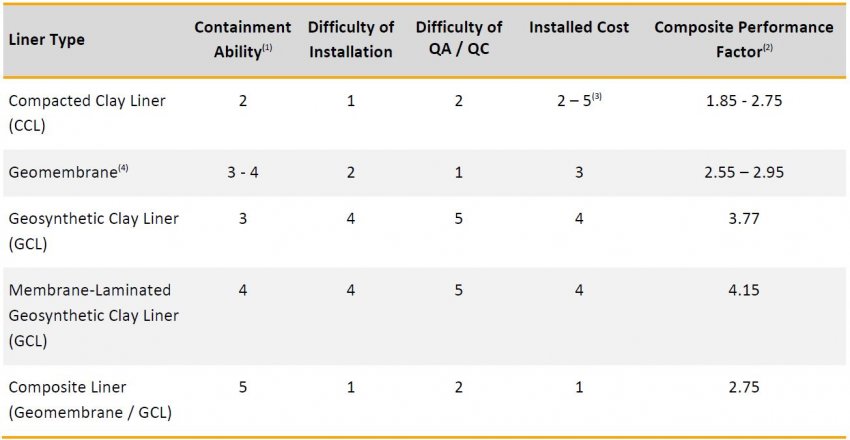For single liner containment applications
Introduction
Uncontrolled waste releases can cause severe environmental damage. Fortunately, modern waste management facilities are designed and constructed to prevent these releases by providing a high level of containment of waste materials. The most obvious means to accomplish containment is to install a bottom liner system in the facility. This discussion evaluates some available liner system alternatives and their performance under various cost, time, and construction constraints. It will be shown that a strong argument can be made for the use of geosynthetic clay linersas the primary barrier component of waste management facilities and other containment systems.
Liner Options
A few of the most popular lining options are summarized in Table 1 below. Also included are estimated leakage rates for the various liners, which are based on theoretical and actual performance data from landfills.

Table 1: Various landfill liner options and their relative containment abilities

Notes:
- Leakage rates in litres/hectare/day, calculated assuming a hydraulic head of 0.3 m is present on each liner.
- Leakage rates calculated using the method of Bonaparte, et. al. (1989).
- Actual number and size of holes depends on installation quality. See references for further information.
- This value is one-hundredth the calculated leakage of 860 lphd for standard geotextile-based GCLs at 1 x 10-11 m/sec permeability. The 100x adjustment is for the geomembrane component of the GCL, which will reduce leakage by an even greater amount.
The information in Table 1 reveals some important concepts:
- All of the liners will dramatically reduce leakage in comparison to the case where there is no liner. The presence of a functional liner system is clearly the most important part of a containment system design.
- The amount of leakage through the liner is lowest when “composite” liners are used; in other words, those liners containing both a geomembrane component and a clay component offer the best performance available.
- Similar to the previous statement, any single liner system—geomembrane alone, clay alone, etc.—will not perform as well as a composite system. The synergistic behaviour of a geomembrane and a clay liner is extremely valuable with respect to achieving the lowest possible leakage values.
Liner Selection Factors
Other factors in addition to leakage performance will affect the choice of a liner system. How is the most appropriate liner system selected? First, it is necessary to evaluate standard design issues such as slope stability, chemical compatibility, site preparation, and others. If this evaluation eliminates any previously considered options, then the final decision of which liner system to select should involve careful consideration of the degree of containment required relative to its ease of installation, quality control/quality assurance requirements, and cost. Why these three issues? It is because they have the greatest influence on overall performance as explained below.
Ideally, the liner system should be easy to install, such that unskilled or semi-skilled labourers can deploy the liner with little or no previous training and with little chance for error. GCLs are clearly the easiest liners to install. Compacted clay liners require highly trained labour, special equipment, and rigorous monitoring of the materials and the materials placement process. Constant control over soil moisture conditions is also critical. Geomembranes require highly skilled labour for proper installation, which is expensive and time consuming if the liner system is deployed in small phases.
The amount of construction quality control and quality assurance (CQC/CQA) depends on the complexity of the liner system and the number of variables that must be controlled in order for the liner to perform at design standards. GCLs are factory-manufactured and therefore have little or no variation compared to natural soils. Geomembranes do not function unless individual panels are properly welded, a highly labour-intensive skill that even today is seldom mastered. Geomembranes are also frequently accidentally punctured, resulting in high leakage rates if these punctures are not detected by a rigorous CQA program. GCLs are self-seaming and self-healing, resulting in far fewer CQA-related problems in a typical application.
Finally, the cost of the liner system must be consistent with the performance it provides. This is where membranelaminated GCLs offer outstanding value. By combining the impermeability of a stand-alone geomembrane with the leak-sealing properties of a GCL, a product such as Claymat CL provides the state-of-the-art performance of a composite liner system at the cost of a single GCL. No other lining technology offers this price/performance ratio.
Quantifying the Selection Process
The selection of the “best” liner for a particular site involves consideration of the above factors in addition to its leakage performance. Table 2 provides a numerical comparison of these factors, resulting in an overall “composite performance factor” which summarizes the overall desirability of a liner system. In this analysis, performance and cost are the greatest importance, while installation difficulty and QA/ QC are given lesser importance.
Table 2: Liner system evaluation, with scores from 1 (worst/most difficult) to 5 (best/least difficult)

Notes:
- Based on data presented in Table 1.
- Composite Performance Factors are weighted averages based on the following components: Containment Ability = 40%; Installation = 15%; QA/QC = 15%; and Cost = 30%.
- Cost varies with the availability of clay soils. Also, the materials cost of geosynthetic liners may be higher than clay, but resulting increased air space adds value to the landfill. Airspace issues are not considered in this analysis.
- Geomembrane assumed to be 60-mil (1.5 mm) HDPE.
Table 2 is only a broad summary of some of the key issues involved in liner system selection and is not intended to be used as design guidance. However, the table does present some interesting results when performance is evaluated in consideration of installation issues and cost. In this analysis, the GCL and the membrane-laminated GCL have the highest performance factors because of their higher scores for some of the additional areas of consideration. This systematic analysis can be repeated using project-specific weighting factors if, for example, cost has a different level of importance than assumed herein.
Conclusions
Selecting the “best” liner for a containment project involves more than just considerations of containment ability. Issues such as ease of installation, QA/QC, and cost must all be considered before such decisions are made. A numerical analysis as presented herein may be helpful in this regard. In the analysis performed above, it is clear that the GCL-based alternatives offer excellent performance and value.
References
Bonaparte, R., Giroud, J.P., and B.A. Gross (1989) “Rates of Leakage Through Landfill Liners,” Geosynthetics ’89 Conference Proceedings, Industrial Fabrics Association International (IFAI), St. Paul, Minnesota, pp. 18-29.
Guglielmetti, J.I., Sprague, C.J., and M.J. Coyle (1997) “Geomembrane Installation and Construction Survivability,” Industrial Fabrics Association International (IFAI), St. Paul, Minnesota, Geosynthetics ‘97 Conference Proceedings, pp. 235-254.
Laine, D.L., and Binley, A.M., and G.T. Darilak (1997) “Locating Geomembrane Liner Leaks Under Waste in a Landfill,”Industrial Fabrics Association International (IFAI), St. Paul, Minnesota, Geosynthetics ‘97 Conference Proceedings, pp. 407- 411.
Laine, D.L., and G.T. Darilak (1993) “Locating Leaks in Geomembrane Liners of Landfills Covered With a Protective Soil, Industrial Fabrics Association International (IFAI), St. Paul, Minnesota, Geosynthetics ‘93 Conference Proceedings, pp.1403-1412.
Othman, M.A., Bonaparte, R., and B.A. Gross (1996) “Preliminary Results of Study of Composite Liner Field Performance,” Proceedings of the 10th GRI Conference, Geosynthetic Research Institute, Drexel University, Philadelphia, PA, pp. 110-137.
Peggs, I.D. (1993) “Practical Geoelectric Leak Surveys With Hand-Held, Remote and Water Lance Probes,” Industrial Fabrics Association International (IFAI), St. Paul, Minnesota, Geosynthetics ‘93 Conference Proceedings, pp. 1523-1532.
Tedder, R.B (1997) “Evaluating the Performance of Florida Double-Lined Landfills,” Industrial Fabrics Association International (IFAI), St. Paul, Minnesota, Geosynthetics ‘97 Conference Proceedings, pp. 425-438.